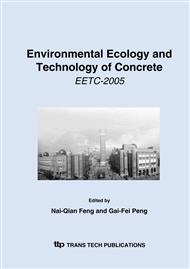p.84
p.91
p.98
p.105
p.111
p.120
p.125
p.131
p.138
Mechanism of Using Mineral Admixtures in Concrete to Suppress Alkali-Silica Reaction
Abstract:
The mechanism of using mineral admixtures in concrete for suppressing alkali-silica reaction has been studied through analyzing pore solution and observing the surface of aggregates in mortar bars with scanning electron microscope (SEM). The results show that when mineral admixtures are used in the concrete, not only the alkali concentration in the pore solution can be reduced, but also the diffusion of alkali ions from the outside of concrete to the inside can be prevented, and the diffusion of alkali ions from the pore solution to the surface of the aggregates can also be prevented. Thus the attack of alkalis to aggregates is reduced, and the alkali-silica reaction is suppressed.
Info:
Periodical:
Pages:
111-119
Citation:
Online since:
January 2006
Authors:
Price:
Сopyright:
© 2006 Trans Tech Publications Ltd. All Rights Reserved
Share:
Citation:


